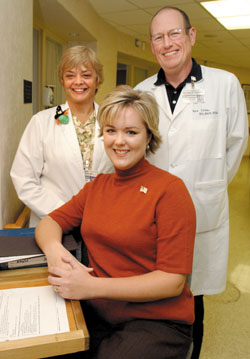
Nurses Sharron Craven and Wendy Beese, front, who are going to work with burn patients in New York City, with Ron Crisp, manager of the Burn Unit. (photo by Dana Johnson)
Burn nurses traveling to New York to help victims
Sharron Craven, assistant manager of VUMC’s Burn Unit, was in a meeting the morning of Sept. 11 when somebody at the table got a page saying a plane had hit the World Trade Center. Those in the meeting found a television in time to watch the second plane hit.
And, apart from the universal reactions of shock and horror, Craven had another thought: “I just want to help.”
She knew there would be many burned patients, and she knew, after 16 years of working with those patients, that she had a skill that could make a difference in the midst of the tragedy.
“I thought, ‘I know how to do this,’” she said.
Now she’s getting her chance.
Craven and another nurse from the Burn Unit, Wendy Beese, will travel to New York-Presbyterian Hospital in Manhattan this weekend to help care for victims from the terrorist attack on the World Trade Center.
Beese found out about the attack after she came back home with her 16-month-old son Noah after dropping her 10-year-old son Nicholas off at school.
“I turned on the TV—I always watch the news in the morning—and saw the second plane hit. I immediately called the unit and said, ‘If you need me, I’m there,’” she said.
In the hours immediately following the attack, VUMC stood ready to accept burn patients from either New York or the attack on the Pentagon in Washington, D.C., but there were so few survivors that transporting patients out of the region was not necessary.
Now, several weeks later, that help is needed because the large number of patients who are so badly injured has begun to take a toll on the nurses who work with them.
New York-Presbyterian’s 40-bed burn unit has 32 patients injured in the World Trade Center attack, and of those, 25 have burns on more than 75 percent of their bodies, Craven said.
“It’s been long enough now that infection is starting to set in,” Craven said. “These patients are extremely ill at this point, and the nurses are tired.
“Burn nursing is very physical. There’s a lot of manipulation of the patients; there’s a lot of rolling and moving of the patients. We do a lot of lifting and repositioning of people. Linens are changed more than once a day. When you go home at the end of 12 hours, you have done a day’s work.”
Beese said she feels fortunate to have exactly the kind of training that is needed by the New York victims. She has been a nurse in the Burn Unit since January, 1999—“As long as I’ve been a nurse,” she said.
Beese and Craven were two of 10 Burn Unit nurses who had volunteered to help if needed, and a call came Tuesday morning, Oct. 2, from the Federal Emergency Management Agency asking if there were any staff at Vanderbilt willing to relieve overworked burn nurses in New York. Other VUMC nurses volunteered to pitch in and work extra shifts if necessary to cover for those who went to New York to help.
“When we found out that some of us might be able to go to New York, there was no thinking about it—I said ‘I want to do it,’” said Beese. “I’m very excited to be able to represent Vanderbilt.”
The Vanderbilt nurses will work at New York-Presbyterian’s William Randolph Hearst Burn Center for two weeks, then return to Nashville, at which time two more Vanderbilt nurses will go if needed.
The nurses will be flown to New York and housed in a hotel near the hospital at no charge and will be scheduled to work two 12-hour shifts, followed by a day off, followed by two more 12-hour days.
“I don’t know what to expect—we’re all a little nervous, “Beese said. Even though his dad Scott and grandmother are around to help, her son Nicholas is also nervous about his mom flying on a plane and going to New York.
“He’s worried, but he’s happy I can help people, and he’s proud of me,” she said.
To give some idea of the task the New York-Presbyterian burn unit is facing, Craven said that Vanderbilt’s Burn Unit, which has 20 beds, would typically have, at most, four patients with the acuity level that 25 of the patients have at the New York hospital.
Apparently, a number of people on the street below the twin towers were caught in a rain of flaming jet fuel, leading to severe burns.
Craven says that, despite the difficulties and special challenges of working with badly burned patients, she loves her work.
“The greatest thing is to see somebody come in here with 90 percent burns, with their family in distress, and then, three months later, see that person walk out. That keeps me coming back every day.”













